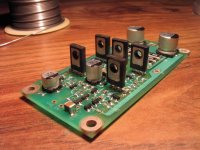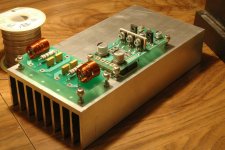so what makes a resistor "lousy" and a capacitor "rotten"?... reliability? unexplainable sonic differences?ingvar ahlberg said:Precision in chipresistors is good but it is still lousy resistors, You can find metalfilm resistors in melfpackages but nothing close to the quality of even the most comon through hole metal film resitors. SMD/SMT is all about producing high volume cheaply.
SMD semiconductors are as good as throug hole types, but filmcapacitors, for instance, are rotten and seldom survive soldering. Drill holes, if You´re not into making cellular phones
SMD/SMT is all about:
- making products smaller - try making a handheld MP3 player using 40 pin DIPs
- improving the electrical performance of things. Lead inductance on a SMT IC package can be an order of magnitude better than that on an equivalent SMT package, and the lead inductance of the capacitor you decouple with it is going to be far less too. This is never a bad thing. And of course, any resistor/capacitor/transistor/etc in SMT form will have less series inductance.
- since a board made with SMT components can be made considerably smaller than one made with through-hole components, track lengths tend to be a lot shorter, radiate less EMI, pick up less crap, etc.
- Try designing a high frequency, high-performance, broadcast-quality PLL using through-hole resistors and capacitors. I dare you.
- reducing waste. When you buy SMT resistors, you don't cut the ends off them and throw them out. Much less solder is required to attach them to a board.
And reliability isn't an issue, provided that proper procedures are taken when SMT assembly is done. Mind you, SMT films and large (eg, 2512) SMT ceramics tend to thermal shock and crack way too easily during reflow. And hand-soldering can destroy a SMT capacitor in no time... so I agree with the "can't survive soldering" comment you made.
- making products smaller - try making a handheld MP3 player using 40 pin DIPs
with SMT, I was able to make an electret mic buffer fit inside a 3" long 10mm dia aluminum tube. I don't think I could have done that with throughhole components. and the SQ is still good. very quiet too.
They are pretty easy to solder by hand.chris ma said:I have tried surface mount polar caps and my experience with them was not very good. The flimsy little flaps are too fragile and broke off very easily. And they are really too small for hand soldering.
Please tell us what you experience with them. What is the best way to solder them?
1 Wet the cap's connections with fresh tin.
2 Put fresh tin on one pad.
3 Warm this pad and slide the capacitor into it's place.
4 Warm the other pad and maybe add some more tin and burn good for a while because you have a very little connection which can be reached by the soldering iron.
Pretty easy!
Since we're talking small... attached is one of the latest things I've designed - a 60W complimentary feedback BJT amplifier, built primarily using 0603 SMT parts on a 1.5" by 3.25" PCB.djQUAN said:
with SMT, I was able to make an electret mic buffer fit inside a 3" long 10mm dia aluminum tube. I don't think I could have done that with throughhole components. and the SQ is still good. very quiet too.
Attachments
Looks very good!  Care for to show us more? (in case of yes, please start a new thread)
Care for to show us more? (in case of yes, please start a new thread)
I'm also into surface mounted as you may have noticed. I persnally realy like it but mostly for it's coolness, maybe also for it's good properties.... them somebody amy ask: how does it sound compared to holemounted parts? I don't know.... because I don't. The only thing I know is that I like it.
 Care for to show us more? (in case of yes, please start a new thread)
Care for to show us more? (in case of yes, please start a new thread)I'm also into surface mounted as you may have noticed. I persnally realy like it but mostly for it's coolness, maybe also for it's good properties.... them somebody amy ask: how does it sound compared to holemounted parts? I don't know.... because I don't. The only thing I know is that I like it.
gmarsh said:
Since we're talking small... attached is one of the latest things I've designed - a 60W complimentary feedback BJT amplifier, built primarily using 0603 SMT parts on a 1.5" by 3.25" PCB.
I assume the output stage is not yet installed? if it's onboard, how do you heatsink it?
Sounds like crap, but I like it!
Peranders,
Someone asked me to pass this along to you.................


PerAnders, you mean you have not even looked at the links on your own website? Maybe what you mean by coolness is an hard icy cold sound in your designs from the passive components you use? I can't understand what other coolness you mean. There are even good sounding passive parts without an "Extreme" price. There are even some SMT resistors than sound better than the standard 1% SMTs chosen at random or for lowest cost. That different passive parts sound different has not been controversial for 20 years and is even well known of the forum.
http://home.comcast.net/~wjungieee/wsb/Picking_Capacitors_1.pdf
http://home.comcast.net/~wjungieee/wsb/Picking_Capacitors_2.pdf
http://www.borbelyaudio.com
In particular:
http://www.borbelyaudio.com/upgrades.asp
Peranders,
Someone asked me to pass this along to you.................
PerAnders, you mean you have not even looked at the links on your own website? Maybe what you mean by coolness is an hard icy cold sound in your designs from the passive components you use? I can't understand what other coolness you mean. There are even good sounding passive parts without an "Extreme" price. There are even some SMT resistors than sound better than the standard 1% SMTs chosen at random or for lowest cost. That different passive parts sound different has not been controversial for 20 years and is even well known of the forum.
http://home.comcast.net/~wjungieee/wsb/Picking_Capacitors_1.pdf
http://home.comcast.net/~wjungieee/wsb/Picking_Capacitors_2.pdf
http://www.borbelyaudio.com
In particular:
http://www.borbelyaudio.com/upgrades.asp
working with high speed current-feedback opamps is more of a problem in through-hole versus surface mount --gmarsh said:
- Try designing a high frequency, high-performance, broadcast-quality PLL using through-hole resistors and capacitors. I dare you.
i would like to see someone compare the film and phenylene sulfide SMT capacitors with their through-hole counterparts.
From what I know these are only available as SMT.jackinnj said:i would like to see someone compare the film and phenylene sulfide SMT capacitors with their through-hole counterparts.
Peter, how many do you want? You can get a couple from me.Peter Daniel said:I was recently experimenting with PLL filter in CS8412 and through hole parts sounded actually better than regular SMD resistors and capacitors.
Any links to those film and phenylene sulfide SMT capacitors, as I would be indeed interested in trying something better.
I could make a thread about it... The amp is more or less stolen from Randy Slone's amp design book (it's a 11.4 with a few component changes, more or less) so I'm not sure if there's any copyright issues involved in posting it. Convince me to make a thread, and I will.peranders said:Looks very good!Care for to show us more? (in case of yes, please start a new thread)
I'm also into surface mounted as you may have noticed. I persnally realy like it but mostly for it's coolness, maybe also for it's good properties.... them somebody amy ask: how does it sound compared to holemounted parts? I don't know.... because I don't. The only thing I know is that I like it.
Here's my impressions on this amp:
I built an "original" slone 11.4 using his parts (2N5401/5551 small signal 2SB649/2SD699 VAS/predriver/bias, 1302/3281 output) and ran into stability problems. I reduced the amp's open loop gain to stabilize it, and it was fine. Sounded great.
This amp uses MMBT5x01, MJE340/350 and MJW21193/4 transistors, and all-original-11.4 component values with the exception of a different DC coupling cap on the input. After building it and powering it up, NO STABILITY PROBLEMS! Didn't have to change a single part.
But the SMT amp sounds... great, too. My ears can't tell a difference.
djQUAN said:I assume the output stage is not yet installed? if it's onboard, how do you heatsink it?
See attachment. And don't laugh at my output board (done in a rush, and I got IN/OUT backwards)
Attachments
gmarsh,
that amp looks really nice! One thing I have against any large SMD components is their mechanical strength to the PCB. At one company I used to work for we finally gave up on large SMD caps for their handheld products. They simply fell off the board all the time after a unit was dropped. SMD connectors can be a PITA too.
Yeah, I'm pretty sure the SMD components themselves are the one to blame. Can't have anything to do with simple loop dynamics, naah...
that amp looks really nice! One thing I have against any large SMD components is their mechanical strength to the PCB. At one company I used to work for we finally gave up on large SMD caps for their handheld products. They simply fell off the board all the time after a unit was dropped. SMD connectors can be a PITA too.
I was recently experimenting with PLL filter in CS8412 and through hole parts sounded actually better than regular SMD resistors and capacitors.
Yeah, I'm pretty sure the SMD components themselves are the one to blame. Can't have anything to do with simple loop dynamics, naah...
Your totally right about that. You must pay attention to if the pcb will be bent especially. Long time ago I used to use resistor nets (SIL's) and the were very sensitive against bending pcb. They crackedSwedish Chef said:One thing I have against any large SMD components is their mechanical strength to the PCB.
- Status
- This old topic is closed. If you want to reopen this topic, contact a moderator using the "Report Post" button.
- Home
- Design & Build
- Parts
- Surface mount capacitors

